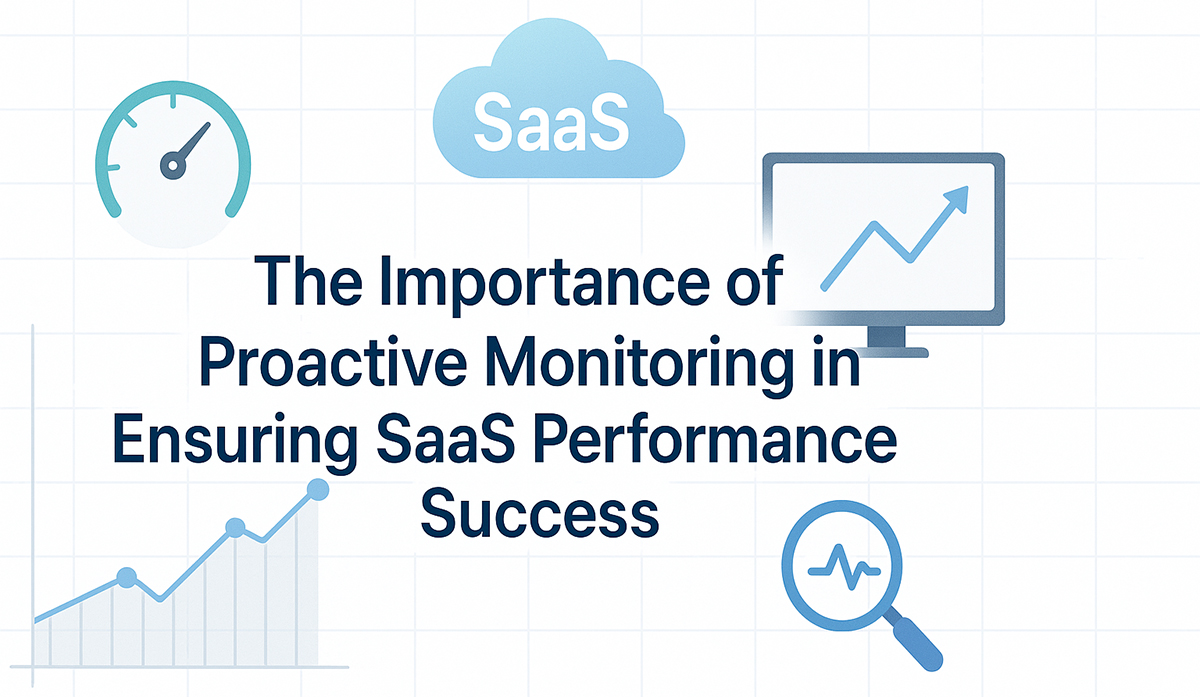No products in the cart.
 In the world of Software as a Service (SaaS), performance and reliability are everything. Users expect fast, smooth, and always-on applications. One small issue can lead to lost customers, negative reviews, and revenue loss. That’s why proactive application monitoring is no longer optional-it’s a critical part of maintaining a successful SaaS operation.
In the world of Software as a Service (SaaS), performance and reliability are everything. Users expect fast, smooth, and always-on applications. One small issue can lead to lost customers, negative reviews, and revenue loss. That’s why proactive application monitoring is no longer optional-it’s a critical part of maintaining a successful SaaS operation.
This blog explores what proactive monitoring is, why it matters, and how it helps businesses stay ahead of problems before they impact users.
What Is Proactive Application Monitoring?
Proactive application monitoring is a preventive strategy where your systems are continuously tracked to detect and resolve potential issues before they cause downtime or performance lags. Instead of waiting for something to break, proactive monitoring helps keep everything running smoothly.
Key Components:
- Continuous Monitoring
Tracks the performance of servers, applications, databases, and network traffic 24/7. - Early Issue Detection
Uses tools like anomaly detection and predictive diagnostics to spot unusual behavior before it becomes a problem. - Proactive Remediation
Sends automatic alerts and enables quick action by your IT or DevOps team, preventing issues from affecting users. - Reduced Downtime
Prevents issues from worsening, thereby guaranteeing optimal application availability.
Why Proactive Monitoring Is Important
Proactive monitoring not only improves technical performance but also brings major business benefits.
✅ Cost Savings
It is significantly more economical to avert issues than to address them subsequently.
✅ Better User Experience
Monitoring ensures that users enjoy a stable, fast, and smooth application every time they log in-boosting satisfaction and trust.
✅ Business Continuity
By preventing major crashes and performance failures, proactive monitoring supports uninterrupted operations and business growth.
✅ Performance Optimization
Real-time insights allow teams to fine-tune applications and systems for better efficiency and speed.
Key Benefits of Proactive Monitoring
| Benefit | Description |
| Minimizes Downtime | Detects and fixes issues early to avoid service disruptions |
| Improves System Health | Keeps servers, databases, and applications running efficiently |
| Increases Stability | Prevents system failures, resulting in more reliable performance |
| Provides Insights | Helps IT teams understand usage trends and areas for optimization |
Common Tools and Techniques Used
To enhance the effectiveness of proactive monitoring, SaaS providers frequently employ a blend of tools and strategies.
- Application Performance Monitoring (APM) Tools
Tools like New Relic, Datadog, and AppDynamics provide real-time performance data-spotting slowdowns, bottlenecks, and resource spikes.
- Logging and Alerting
Comprehensive logs and automated alerts notify teams immediately when anomalies occur, helping them respond quickly.
- Load Testing
Mimics actual user traffic to evaluate the application’s performance under stress conditions. Assists in pinpointing vulnerabilities prior to user experience.
- Capacity Planning
Predicts future needs based on current usage trends. Guarantees that the infrastructure can accommodate increasing traffic without experiencing delays.
Server Monitoring Example: Real-World Scenario
Let’s take a simple example of how server monitoring works in a SaaS environment:
Scenario: High CPU Usage Detected on App Server
Monitoring Tool: Datadog / Zabbix / Nagios
Server: Application Server hosting your SaaS backend
Metric Monitored: CPU Usage Threshold set at 85%
Proactive Monitoring in Action:
- Anomaly Detected
The monitoring system detects CPU usage consistently hitting 90% over a 5-minute period. - Immediate Alert Triggered
An alert is sent to the DevOps team via Slack and email, including log snippets and process-level metrics. - Root Cause Analysis (RCA)
Engineers use logs and metrics to identify a background job stuck in a loop, consuming resources. - Proactive Action Taken
The process is killed, and a patch is deployed to fix the code logic. Monitoring confirms CPU returns to normal. - Outcome
No users have been impacted, there was no downtime, and the system’s health has been proactively restored.
| Metric | Before Monitoring | With Proactive Monitoring |
| CPU Spikes | Undetected | Alerted & Resolved Fast |
| User Impact | High Risk | None |
| System Uptime | Decreased | Maintained at 99.99% |
| Developer Time | Firefighting | Proactive Maintenance |
This kind of server-level visibility is crucial for maintaining application performance and user experience in real-time.
Simple Diagram: How Proactive Monitoring Works
+—————————-+
| Application Performance |
+—————————-+
|
v
+—————————-+
| Real-Time Monitoring Tools|
+—————————-+
|
v
+—————————-+
| Identify Anomaly or Risk |
+—————————-+
|
v
+—————————-+
| Alert Team & Take Action |
+—————————-+
|
v
+—————————-+
| Safeguard System Uptime |
+—————————-+
Proactive application monitoring serves not only as a technical approach but also as a facilitator for business success. By continuously watching over your systems and acting on early warning signs, you can ensure your SaaS application is stable, fast, and always available. This results in reduced expenses, increased customer satisfaction, and an enhanced brand reputation.
At Actsupport, we specialize in round-the-clock monitoring and support services that help SaaS businesses deliver seamless digital experiences. Our proactive monitoring solutions keep your applications healthy, your users happy, and your business moving forward.Stay updated! Follow us on social media! Facebook, Twitter, LinkedIn
Check out our newest blog entry (DevOps Drives Modern Infrastructure Success)



